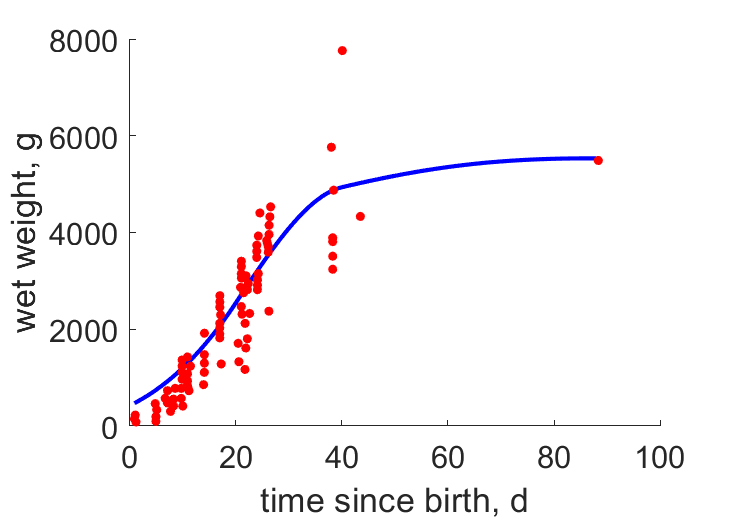Predictions & Data for this entry
| Model: std | climate: Csa, Dfa, Dfb | migrate: | phylum: |
| COMPLETE = 2.7 | ecozone: TPa, THp | food: biCvf | class: |
| MRE = 0.050 | habitat: 0iFl, 0iFe | gender: Dg | order: |
| SMSE = 0.016 | embryo: Tnpfm, Tnsfm | reprod: O | family: |
Zero-variate data
| Data | Observed | Predicted | (RE) | Unit | Description | Reference |
|---|---|---|---|---|---|---|
| ab | 36 | 34.88 | (0.03109) | d | age at birth | AnAge |
| tx | 88 | 88.25 | (0.002885) | d | time since birth at fledging | DiMaClar2017 |
| tp | 264 | 271.9 | (0.02983) | d | time since birth at puberty | guess |
| tR | 1095 | 1095 | ( 0) | d | time since birth at 1st brood | AnAge |
| am | 1.971e+04 | 1.973e+04 | (0.00121) | d | life span | AnAge |
| Wwb | 110 | 111.2 | (0.01124) | g | wet weight at birth | avibase |
| Wwi | 4970 | 4956 | (0.00279) | g | ultimate wet weight | avibase |
| Wwim | 6920 | 6897 | (0.003287) | g | ultimate wet weight for males | avibase |
| Ri | 0.005479 | 0.005528 | (0.008849) | #/d | maximum reprod rate | AnAge |
Uni- and bivariate data
| Data | Figure | Independent variable | Dependent variable | (RE) | Reference |
|---|---|---|---|---|---|
| tW |  | time since birth | wet weight | (0.2285) | DiMaClar2017 |
Pseudo-data at Tref = 20°C
| Data | Generalised animal | Pelecanus erythrorhynchos | Unit | Description |
|---|---|---|---|---|
| v | 0.02 | 0.024 | cm/d | energy conductance |
| p_M | 18 | 1644 | J/d.cm^3 | vol-spec som maint |
| k_J | 0.002 | 0.06644 | 1/d | maturity maint rate coefficient |
| k | 0.3 | 0.296 | - | maintenance ratio |
| kap | 0.8 | 0.9348 | - | allocation fraction to soma |
| kap_G | 0.8 | 0.7996 | - | growth efficiency |
| kap_R | 0.95 | 0.95 | - | reproduction efficiency |
Discussion
- Males are supposed to differ from females by {p_Am} only
- mod_1: v is reduced
- mod_2: Pseudo-data point k is used, rather than k_J; Data set tp and parameter t_R are added, the latter replacing clutch interval t_N. Postnatal T is based on PrinPres1991, see get_T_Aves. See further the revision page, theme puberty
Bibliography